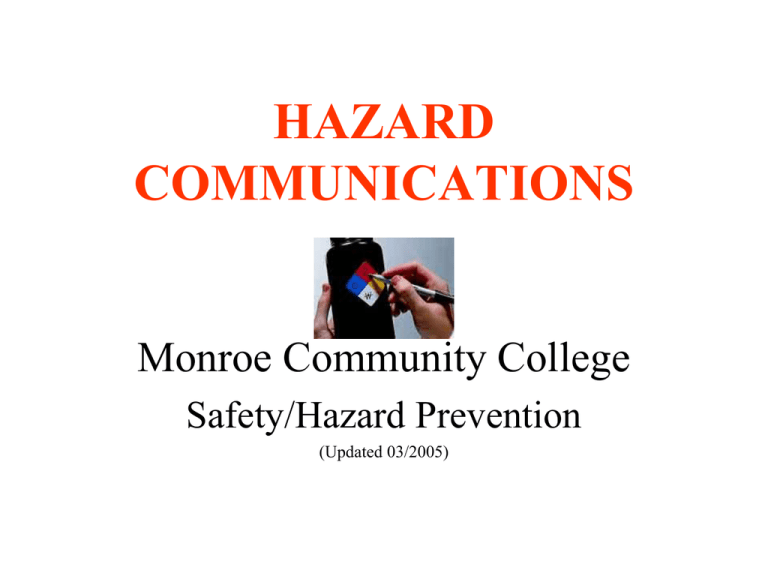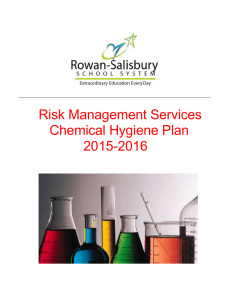Haz Com PPT - Monroe Community College
advertisement

HAZARD COMMUNICATIONS Monroe Community College Safety/Hazard Prevention (Updated 03/2005) HAZARD COMMUNICATION • Chemicals are certainly useful, on the job and off. But as we all know by now, many chemicals are hazardous to your health if you are exposed to too much of them or if the exposure is too direct. 2 What Can I Be Exposed To At MCC? • • • • Maintenance Machinery Construction Projects Chemicals in the Workplace ****Chemicals brought from home….. 3 Chemical Inventory Lists • List of chemicals in your specific workplace • MUST be completed ANNUALLY by a designee in your department • RIGHT-To-Know 4 The Hazard Communication Standard is specifically concerned with chemical hazards—the chemical's physical and health risks to people. A chemical may have three basic physical hazards: 1. Fire. You have to know if a chemical could, in a liquid, gas, or vapor form, catch fire and under what circumstances. 2. Explosion. You also have to know if there are circumstances under which a chemical might explode. 3. Reactivity. This is the potential of a chemical to catch fire or explode if it's combined with other chemicals or with water or air. You need to know what the chemical should be kept away from and what situations to avoid. Bobbi J. Huffer 5 NFPA 704 Labels 6 Health Hazard 4 Very short exposure could cause death or serious residual injury even though prompt medical attention was given. 3 Short exposure could cause serious temporary or residual injury even though prompt medical attention was given. 2 Intense or continued exposure could cause temporary incapacitation or possible residual injury unless prompt medical attention is given. 1 Exposure could cause irritation but only minor residual injury even if no treatment is given. 0 Exposure under fire conditions would offer no hazard beyond that of ordinary combustible materials. 7 Flammability 4 Will rapidly or completely vaporize at normal pressure and temperature, or is readily dispersed in air and will burn readily. 3 Liquids and solids that can be ignited under almost all ambient conditions. 2 Must be moderately heated or exposed to relatively high temperature before ignition can occur. 1 Must be preheated before ignition can occur. 0 Materials that will not burn. 8 Instability1 4 Readily capable of detonation or of explosive decomposition or reaction at normal temperatures and pressures. 3 Capable of detonation or explosive reaction, but requires a strong initiating source or must be heated under confinement before initiation, or reacts explosively with water. 2 Normally unstable and readily undergo violent decomposition but do not detonate. Also: may react violently with water or may form potentially explosive mixtures with water. 1 Normally stable, but can become unstable at elevated temperatures and pressures or may react with water with some release of energy, but not violently. 0 Normally stable, even under fire exposure conditions, and are not reactive with water. 9 ACID This indicates that the material is an acid, a corrosive material that has a pH lower than 7.0 ALK This denotes an alkaline material, also called a base. These caustic materials have a pH greater than 7.0 COR This denotes a material that is corrosive (it could be either an acid or a base). This is a another symbol used for corrosive. 10 The skull and crossbones is used to denote a poison or highly toxic material. See also: CHIP Danger symbols. The international symbol for radioactivity is used to denote radioactive hazards; radioactive materials are extremely hazardous when inhaled Indicates an explosive material. This symbol is somewhat redundant because explosives are easily recognized by their Instability Rating. 11 You also have a right to know about any health hazards, which can be anything from a skin rash to lung cancer. The Standard makes sure you are informed about the possible health hazards of any given chemical, the symptoms to watch out for, and any existing medical condition that the chemical might make worse. 12 You should be able to identify the hazards of any chemical before you use it with two key Hazard Communication tools: • Container labels have to provide you with basic information on the chemical's hazards and on the basic procedures and protective equipment you should use when working with it. The label probably also has basic handling and storage instructions and some first-aid information. • Material safety data sheets have all the details—everything you ever considered knowing about the chemical, its hazards, and instructions for safe handling, use, disposal, and storage. There is also information on what to do if the chemical spills or leaks and first-aid instructions to follow in the event of an accident. 13 MATERIAL SAFETY DATA SHEET SECTIONS • • • • • • Section 1: Chemical identity Section 2: Hazardous ingredients/identity Section 3: Physical/chemical characteristics Section 4: Fire and explosion hazard data Section 5: Reactivity data Section 6: Health hazard data. – Inhaling – Swallowing – Through the skin. 14 MATERIAL SAFETY DATA SHEET SECTIONS Section 7: Precautions for safe handling and use Section 8: Control measures 15 Chemical Example • Petroleum Naptha • What Is It???? 16 Section 1: Chemical identity WITE-OUT PRODUCTS, INC. -- WHITE-OUT FOR EVERYTHING CORRECTION FLUIDS -- 7510-01-381-1876 ===================== Product Identification ===================== Product ID:WHITE-OUT FOR EVERYTHING CORRECTION FLUIDS MSDS Date:09/29/1997 FSC:7510 NIIN:01-381-1876 Status Code:A MSDS Number: CLBMY === Responsible Party === Company Name:WITE-OUT PRODUCTS, INC. Address:145 SOUTHCHASE BLVD. City:FOUNTAIN INN State:SC ZIP:29644 Country:US Info Phone Num:203-783-2103 Emergency Phone Num:800-424-9300 CHEMTREC Preparer's Name:U.S. TESTING CO.,INC. Chemtrec Ind/Phone:(800)424-9300 CAGE:4Z203 Bobbi J. Huffer 17 === Contractor Identification === Company Name:WITE-OUT PRODUCTS INC Address:10114 BACON DR Box:City:BELTSVILLE State:MD ZIP:20705-2101 Country:US Phone:203-783-2000 CAGE:4Z203 18 Section 2: Hazardous ingredients/identity ============= Composition/Information on Ingredients ============= Ingred Name:PETROLEUM NAPHTHA CAS:6474248-9 RTECS #:1002859HN Fraction by Wt: 40.0% Other REC Limits:FLAMABLE OSHA PEL:400 PPM ACGIH TLV:400 PPM 19 First Aid ======================= First Aid Measures ======================= First Aid:SKIN: WASH W/WATER. CONSULT PHYSICIAN IF IRRITATION OCCURS AND PERSISTS. EYES:W/SOAP & WATER. SEE DR. INHAL: GET FRESH AIR. ALERT EMERGENCY MED PERSONEL. GIVE ARTIFICIAL RESPIRATION IF NEEDED. INGEST : CALL DR AT ONCE. DONT INDUCE VOMITING. GET IMMED MED AID IN ALL CASES. 20 PERSONAL PROTECTIVE EQUIPMENT • • • • • • GOGGLES SAFETY GLASSES GLOVES HEARING PROTECTION SHOES/ OVERBOOTS BBP CLEANUP EQUIPMENT 21 What Do I Do If I Am Exposed to Any Chemical On Campus? • 1. Notify your Supervisor immediately • 2. ID the chemical and call 2911—NOT 911 via your cell phone • 3. Render First Aid measures • 4. Have a Public Safety Report taken by an officer for any injury RIGHT AWAY 22 What If I Smell A Strange Odor on Campus? • 1. Make sure it isn’t caused by something in your office or directly outside FIRST • 2. Call X2911 and report it…NOT the Safety Office • **Many reports are from cigarette smoking outside offices or lawnmowers—fumes are gone by the time officers arrive. • Is this a danger to me?? • Parking garages… 23 CONCLUSION Always start your preparation for a job involving a hazardous chemical with these three steps: 1. Read the container label. 2. Read the material safety data sheet. 3. Follow the instructions and precautions on the material safety data sheet. 24







